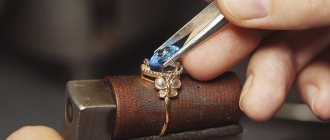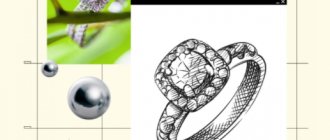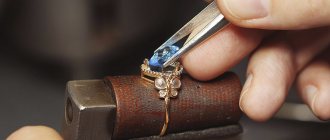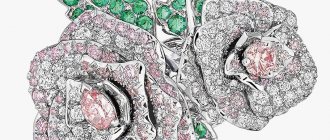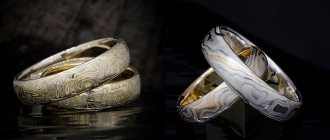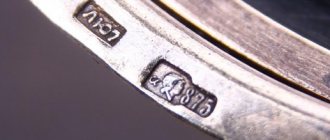<Read all reports from student screenings and defenses under the TRAINING tag>
The profession of a jeweler is experiencing a rebirth, and is “overgrown” in a variety of directions. People who are interested in learning today mean a variety of things: jewelry making as a craft, jewelry design, entrepreneurship and running your own jewelry brand, managing a jewelry company or its division, being an expert (for example, stone grading), and much more.
Let's go through the main options for obtaining a jewelry specialty - from the most thorough (universities) to secondary professional (colleges) and highly specialized (courses, master classes).
In this article we have posted the main, most famous jewelry schools. The situation in the field of education today is changing very quickly, different schools are merging, and familiar names are changing. Write to us if we missed something or the information has changed since our publication - we will promptly make changes!
What does the profession of a jeweler include?
Before you learn to be a jeweler and become a real master, it’s worth understanding what such a professional actually does.
Learn the basics of the profession and understand what skills are needed to get started. A jeweler is a professional who works with precious metals and stones. There are narrowly focused craftsmen who work only with cutting, finishing or casting. As well as general specialists who can turn a piece of raw gold and gemstone into a real work of art.
Thanks to the development of technology, you can learn the skill of creating 3D models of jewelry, on the basis of which automation will produce a suitable product. And also master artistic painting on precious metals using enamel and turn into an artist.
Regardless of your specialization, to become a jeweler, you need to start by studying the properties of metal alloys, precious stones and basic working techniques. And also understand whether painstaking and careful work is suitable for you or whether computer graphics is closer.
Statistics data. A craftsman who works manually with precious metals earns on average from 35 to 70 thousand rubles per month. Designers who can create a piece of jewelry from scratch are paid a piece rate for each piece.
Jewelry schools: colleges and secondary vocational education
First of all, specialized colleges and schools are of interest - arts and arts and crafts. Most of them are departments of universities from the first group:
MOSCOW: Moscow branch of the Higher School of Folk Arts (formerly the Institute of Traditional Applied Arts) - college (secondary vocational education) - see above in the universities section.
MOSCOW (MOSCOW REGION): Art and Industrial College named after Vasnetsov, Abramtsevo branch of the Moscow Academy named after. S.G. Stroganov. Prepares artists of decorative and applied arts (wood carving, stone carving, metal carving, bone carving, design, etc.) Duration of training: 3g 10m Address: Khotkovo village, Moscow region Website: ahpkv.ru
MOSCOW: College of Decorative and Applied Arts No. 36 named after Carl Faberge The college was created in 2005, and offers training in the specialty “Jeweler”, as well as “Incrustation” and “Design in the jewelry industry”. College graduates who are professional jewelers become heads of production sites, leading designers, artists and technologists, and owners of their own businesses. College graduates with the profession of “Jeweler” can continue their studies at the college with a specialty in “Design in the Jewelry Industry”, as well as in higher educational institutions. Duration of training: 3 years 5 years - based on 9 classes, or 1 year 10 years based on 11 classes Address: Moscow , st. Shipilovskaya, 17/1, building 2 Website: collegefaberge.mskobr.ru
MOSCOW: The first Moscow educational complex was created in 2014 on the basis of four Moscow colleges: Technological College No. 14, College of Arts and Crafts No. 59, College of Entrepreneurship No. 15, Moscow Art and Pedagogical College of Technology and Design. The complex offers the specialty “Jeweler” (as well as, for example, the specialty of decorative and applied arts). Address: Moscow, Tikhomirov str. 10 k.1 Website: artcollege.ru
KOSTROMA: Krasnoselskoye School of Artistic Metalworking (KUKHOM) is a branch of the Moscow Academy named after. S.G. Stroganov. Provides training for specialists in full-time secondary vocational education programs. At KUKHOM they train to be: - designer for the jewelry industry (training period 3 years 10 years) - artist of folk arts and crafts (training period 2 years 10 years) Address: Kostroma region; village Krasnoe-on-Volga Website: https://www.kyxom.ru
In addition to specialized courses, jewelry making can also be studied in colleges with a more universal focus. The profession of a jeweler in such schools is presented along with numerous other specialties useful for the “national economy”. There are similar secondary vocational educational institutions in many cities. Let's give examples of several Moscow schools:
MOSCOW: College of Entrepreneurship No. 11 Among other specialties, they train there to become a “Diamond cutter into brilliants.” Graduates can perform all diamond cutting work using modern equipment and technological equipment. There are budget and commercial options. Website: kp11.mskobr.ru
MOSCOW: Polytechnic College No. 13 named after P.A. Ovchinnikov The technical school, among other specialties, declares “Jeweler - basic training.” According to the information on the website, training is free, enrollment without exams. Graduates receive a state diploma of secondary vocational education with secondary general education. Duration of training: 3g 5m (based on 9 classes) or 1g 10m based on 11 classes. Address: Moscow city, Bibirevskaya street, 6, bldg. 1 Website: spo-13.mskobr.ru
SAINT PETERSBURG: SGBPEU “Artistic and Professional Lyceum of St. Petersburg named after Carl Faberge” - where they will teach the specialty “jewelry” on the basis of 9 or 11 grades. Address: St. Petersburg, Energetikov Ave., 4, building 2 (Ladozhskaya metro station) Website: hpl11.ru
EKATERINBURG: The Ural technical school "Rifey" will help you master the craft of a jeweler. Training based on grades 9 or 11, qualification - jeweler, cutter. Website: ut-rifey.ru/obrazovanie/80-54-01-02-yuvelir
ROSTOV-ON-DON: DPTK PU 8, multifunctional center for applied qualifications - courses for jewelers (vocational training program), 5 months, introduction to the profession. Address: https://pu8vertol.ru/index/kontakty/0-5 Website: https://pu8vertol.ru/index/prof_obrazovaniye/0-51
NIZHNY NOVGOROD: Pavlovsk College of Folk Art Crafts of Russia, there are specialties of jeweler, designer and others Address: Nizhny Novgorod region, Pavlovo, Mayakovsky, 28 Website: https://www.arts-college.ru/
Main trends in jewelry
To study to become a jeweler, you need to choose a field of activity. It is impossible to master everything at once in any profession. The main specializations of the masters include:
- creating models of future products, preparing sketches and transferring them to a 3D version;
- casting, processing and mounting of metal precious parts of future works of jewelry;
- applying ornaments, patterns, fonts, engravings and other decorative elements;
- processing of precious stones and their fixation in products;
- creating designs using jewelry enamel, applying a special protective layer, spraying and working with colored clay.
As a rule, a good jeweler does not have difficulties finding employment. Craftsmen are hired to work in salons, workshops, plants and factories, as well as in pawnshops, jewelry stores and shops. Even expert companies that verify the authenticity of precious alloys require experts in their field.
Jewelry Modeling Course from Jewel Courses
| Duration | 1–2 months |
| Level | From scratch |
| Who is it suitable for? | For beginning jewelers, beginners |
| Format | Online lectures + homework + feedback from the mentor |
| Results | Certificate + project in portfolio |
| Price | 12,000 rubles |
| Link to course | Find out details |
Content. The curriculum includes the following lesson topics:
Teacher:
Mikhail Rachinsky is a teacher, jewelry designer.
After completing the course you will be able to:
- use the Blender 3D modeling package;
- master the basics of jewelry making;
- build stages of product development;
- come up with design ideas;
- grow a wax model on a 3D printer;
- master the technological requirements of jewelry production.
My impressions: The course is divided into 3 parts, each of which provides important knowledge. In the first, you study tools, in the second, 3D modeling, and in the third, organizing your own work and jewelry production technology. All this is needed to fully understand it. how jewelry is created. Thanks to this knowledge, you can find your first clients and start earning money!
What skills will be required for the job?
There are many courses on the global network “How to become a jeweler” that offer training in the basics of craftsmanship. But before signing up for free and paid trainings, professionals recommend reading Erhard Brepohl’s book “Theory and Practice of Jewelry Making.” And also analyze your character and understand whether it has the following traits:
- perseverance, because manual work is very painstaking;
- curiosity - all jewelers are constantly improving their skills;
- analytical mind to study all the properties of alloys;
- creative spirit to create unique sketches;
- patience, because not everything works out the first time;
- the ability to sell your skills to get a job in the future or receive direct orders as a self-employed citizen.
Skills in working with a blowtorch, jigsaw and nail file will also come in handy if you want to work with the metal itself. Ability to work in 3D modeling programs when you decide to become a jewelry designer. As well as the ability to carefully and smoothly process stones when choosing to work with gems.
Where can you study to become a jeweler: what courses to choose to start with
Real masters say that they study their art all their lives. Jewelers literally live by their craft, constantly learning new techniques for creating jewelry. On average, to become a master in at least one area, it takes more than 3 years with daily practice of 3-4 hours a day.
Are you ready to devote yourself to jewelry making? Then you should start learning jewelry making in the following sequence:
- Master the basic theory of jewelry making. To do this, select 2-3 books and read them before starting training.
- Find offline courses in your city. Live training under the guidance of a master will always give more results than independent practice.
- Look for free online jewelry making courses. They will help you understand whether this profession is right for you before you plunge headlong into it.
- Choose a master who will become your real curator and friend. There is always a chance to negotiate with a professional to take you on as a student.
And also purchase a minimum number of tools in advance. They are selected depending on the direction you decide to choose. For example, if you want to work only with artistic painting, then you should stock up on special brushes and ingredients to create unique paintings.
Online mini-course “Jewelry” from Kalacheva School
| Duration | 12 months |
| Level | From scratch |
| Who is it suitable for? | For any level of training |
| Format | Video lectures + practice |
| Guarantees | You can choose to access the course forever |
| Results | Certificate |
| Price | ● Access for a year – 2,990 rubles; ● access for 3 months - 1,990 rubles; ● access to courses is paid separately. |
| Link to course | Find out details |
Content. The course program includes the following blocks:
Mentors:
Anna Mikheeva is a teacher at the School of Drawing, author of a mini-course.
After completing the course you will be able to:
- draw images of jewelry;
- select materials for work;
- draw necklaces, earrings and rings.
My impressions: The course is video recordings of lessons without verification by a curator. You will learn how to draw jewelry with markers. To study, you'll need paper, markers, colored pencils, and a white gel pen so you can practice right away. It is possible to choose your own course package and separately access to materials for 1 month, six months or a year. The mini-course “Jewelry” is included in the “Fashion Illustration” block, so you can continue learning. Do you want to draw cool necklaces, earrings and rings? Then sign up!
